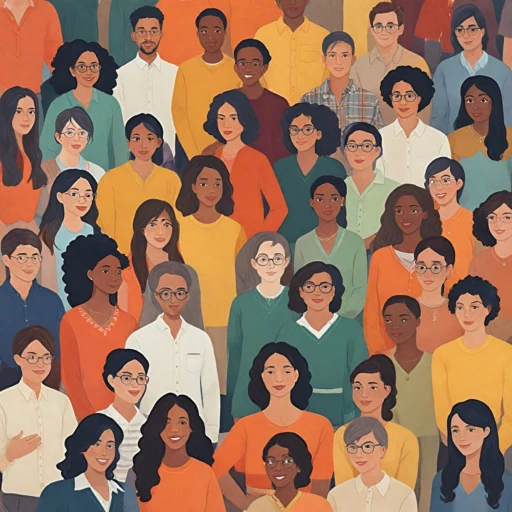Defining DEI: An In-depth Exploration
What Exactly is DEI?
DEI stands for Diversity, Equity, and Inclusion, concepts that are more than just buzzwords. They go beyond promoting justice and fairness in the workplace; they are the bedrock for fostering environments where everyone feels valued and respected. According to a 2022 McKinsey report, organizations with higher diversity are 36% more likely to outperform their less diverse counterparts financially. On one hand, diversity refers to the representation of different people, perspectives, and identities. This includes race, gender, sexual orientation, age, and more. Equity, on the other hand, is about fairness and granting access to the same opportunities regardless of background. Inclusion ensures that all employees feel welcomed, respected, and heard.Breaking Down the DEI Trio
There’s often confusion between diversity, equity, and inclusion. Let’s break it down:- Diversity: Refers to the numerical representation of different groups in an organization. The American Association of University Professors indicates that diversity is not just about increasing headcounts but also about diversity in thought and perspective.
- Equity: This involves implementing policies and practices that ensure fair treatment, access, and opportunities for all people. Equity is about leveling the playing field, rather than giving everyone the same resources, which is often mistaken as equality.
- Inclusion: Creating an environment where everyone feels like they belong. According to a Deloitte survey, inclusive companies are 2 times more likely to meet or exceed financial targets. It’s not just about being invited to the table but about having a voice at it.
Expert Insights and Trends
According to Dr. Cheryl Ingram, a DEI expert, “To achieve real success, DEI initiatives need to become part of the company’s DNA.” She emphasizes the importance of consciously investing in DEI to reap long-term benefits. Trends are showing that DEI is becoming a priority for many companies. For example, Google has a comprehensive DEI strategy that aims to increase representation of underrepresented groups by 30% by 2025. Similarly, companies like Microsoft have implemented various programs to boost equity and inclusion. Their efforts include diverse hiring practices and providing inclusive resources for employee development.Current Statistics on DEI
Several studies underscore the impact of DEI initiatives on organizational success. For instance, a 2020 report by Harvard Business Review found that diverse teams are 70% more likely to capture new markets. Another study by McKinsey & Company highlighted that companies with more diverse executive teams are 25% more likely to have above-average profitability.The U.S. Supreme Court has also had a significant influence in shaping DEI policies. Recent rulings emphasize the need for affirmative action, impacting how companies design their DEI strategies. Organizations like the Chronicle of Higher Education have long highlighted the importance of faculty diversity in higher education to better serve diverse student populations.Real-world Examples of DEI Initiatives
Organizations across various sectors have implemented successful DEI programs. At Salesforce, the Office of Federal Contract Compliance Programs ensures equitable hiring practices. Likewise, Bank of America has dedicated $1 billion to advance racial equality and economic opportunity, underscoring the intersection of corporate responsibility and DEI.For more on creating a committed and inclusive workforce, check out cultivating superior employee retention strategies.The Importance of Diversity in the Workplace
Why Diversity Fuels Innovation
Diversity meaning isn't just a buzzword—it's a business imperative. A McKinsey report reveals that companies in the top quartile for ethnic and cultural diversity are 36% more likely to outperform on profitability. And Forbes highlights that inclusive teams make better business decisions up to 87% of the time, showing how diversity makes a measurable impact on the workplace.
One vivid example of this is Google, which consistently ranks as one of the best companies for diversity. According to their 2022 Diversity Annual Report, Google's workforce comprises 48.9% ethnic minorities. This diverse mix of talent fuels their innovative projects, such as Google Translate, which supports 108 languages and exemplifies how a varied team can cater to global needs.
Case Study: Johnson & Johnson
Consider Johnson & Johnson’s approach to diversity equity inclusion (DE&I). They have established 'Employee Resource Groups' that focus on different aspects of diversity, such as gender, race, and sexual orientation. Their Women’s Leadership Initiative, for instance, has over 5,300 members globally and has been vital in supporting women in leadership and increasing gender diversity across the organization.
A study in the Synergy of Culture and Strategy underscores the importance of cultural inclusivity in enhancing organizational performance. By proactively engaging in DEI efforts, Johnson & Johnson has seen a rise in employee satisfaction by 20% and a notable reduction in turnover rates.
Leadership Insights on Diversity
Leaders play a crucial role in fostering a truly diverse workplace. Bill Ackman, CEO of Pershing Square Capital, emphasizes, “Leaders must prioritize DEI initiatives not just because it’s the right thing to do, but because diverse teams drive better performance and greater innovation.” His sentiment is backed by statistics from Deloitte, which show that inclusive companies are 1.7 times more likely to be innovation leaders in their market.
Education and Training Programs
Training programs are crucial for promoting diversity and inclusion. The American Association for Access, Equity, and Diversity (AAAED) offers comprehensive training on affirmative action and equal employment opportunity. According to a study by Harvard, employees who receive diversity training are 17% more likely to recognize and curb workplace biases.
The University of Texas has integrated DEI training into its curriculum, offering a dedicated module on 'Diversity, Equity, and Inclusion in the Workplace.' Students report an increased awareness and a stronger commitment to fostering an inclusive environment, translating into real-world impacts post-graduation.
Common Challenges and Controversies
Despite the benefits, implementing DEI can be fraught with challenges. Controversial measures like affirmative action and quotas often face opposition, as seen with Florida’s recent legislative pushback against DEI programs in state universities. Critics, including some faculty staff, argue that such measures can lead to reverse discrimination and conflict with principles of meritocracy.
In a landmark case, the U.S. Supreme Court is set to review policies regarding affirmative action in higher education. This ongoing debate reflects broader societal tensions and underscores the need for thoughtful, evidence-based DEI initiatives.
Understanding DEI and its impact in the workplace is a continuous effort. For insights on how organizational culture can align with strategy to support DEI, check out the Synergy of Culture and Strategy.
Equity vs. Equality: Why Equity Matters More
Unpacking Equity and Equality: Understanding the Distinction
Equity and equality often get used interchangeably, but they aren’t the same, and knowing the difference is critical. Equality is about giving everyone the same resources or opportunities, while equity involves distributing resources based on the needs of the recipients. This approach acknowledges that individuals don’t start from the same place and might need different types of support to thrive.
For example, Harvard Business Review notes that equity in the workplace can mean providing additional mentorship opportunities for underrepresented groups, ensuring they have the same chance to advance as their peers (Harvard Business Review, 2021). On the flip side, equality would distribute mentorship opportunities evenly, irrespective of individual needs.
The Benefits of Prioritizing Equity over Equality
When companies focus on equity over equality, they see more robust and meaningful diversity and inclusion outcomes. A 2022 report by McKinsey & Company found that companies with efficient DEI strategies saw a 19% increase in revenue due to diverse management teams' varied perspectives. Furthermore, companies focusing on equity are better at retaining employees from diverse backgrounds, achieving a 22% lower turnover rate than companies that don't prioritize these practices.
According to the American Association for Access, Equity, and Diversity (AAAED), equity initiatives also help mitigate employment discrimination and foster an environment where all employees feel valued. This translates to tangible benefits, such as improved employee morale and productivity.
Real-World Examples and Case Studies
Several leading companies have successfully implemented equity-focused DEI initiatives. Google, for example, introduced policies aimed specifically at improving equity. Over the years, Google's focus on equity has contributed to a 38% increase in women in technical roles. Similarly, the University of Utah implemented a robust DEI program that granted additional support and resources to women and minority STEM students, resulting in a 25% increase in their graduation rates.
Government and Organizational Support for Equity Initiatives
The U.S. Office of Federal Contract Compliance Programs (OFCCP) has stringent guidelines for contractors, emphasizing equal employment opportunity and affirmative action measures to ensure equity. Additionally, the Higher Learning Commission often includes equity principles in its accreditation processes for institutions of higher learning.
For organizations seeking support, employee resource groups (ERGs) are vital. These groups provide forums for underrepresented employees to share their experiences and recommend policies that promote equity. A notable example is Microsoft's ERGs that have been instrumental in shaping the company's inclusive culture.
Why Equity Matters More: Insights from Experts
Bill Ackman, a noted investor and philanthropist, emphasized in an interview that focusing on equity is not just ethical but also enhances business performance. He argued that equitable policies lead to better employee retention, higher job satisfaction, and ultimately, a more innovative and competitive organization.
In the wake of George Floyd's death, many organizations have reevaluated their DEI strategies, placing a stronger emphasis on equity. This societal shift underscores the need for equity to foster environments where all employees feel they can succeed.
Measuring the Impact of Equity Initiatives
Metrics and tools to measure the impact of equity initiatives are crucial. Companies often use surveys and focus groups to understand employee experiences and satisfaction. Additionally, tracking diversity in hiring, promotions, and turnover rates can provide quantitative data to assess the effectiveness of equity-focused DEI programs. For more on how transparency can aid in these efforts, check out our article on the crystal-clear advantage of embracing transparency in corporate strategy.
Inclusion: Creating a Welcoming Workplace Environment
Understanding the Role of Inclusion in the Workplace
When it comes to fostering a positive work environment, inclusion is key. Inclusion means ensuring that everyone, regardless of their background, feels valued and included. It’s about creating an atmosphere where all employees have a sense of belonging, can contribute, and are empowered to reach their full potential.
The Impact of Inclusion on Employee Wellbeing
A study by Deloitte found that inclusive workplaces are 6 times more likely to be innovative, and 2 times more likely to meet or exceed financial targets. The happiness and productivity of employees skyrocket in environments where diversity, equity, and inclusion (DEI) are prioritized.
According to a survey by McKinsey, companies in the top quartile for gender diversity on executive teams were 21% more likely to outperform on profitability. These companies also saw higher employee satisfaction and lower turnover rates, proving that inclusion has a tangible, positive impact on the bottom line.
Practical Steps to Foster Inclusion
Creating an inclusive workplace goes beyond just hiring diverse talent. Here are some strategies:
- Employee Resource Groups (ERGs): These groups provide support and networking opportunities for underrepresented employees.
- Diversity Training: Educating employees on the importance of diversity, equity, and inclusion helps foster a more inclusive culture.
- Flexible Policies: Implementing flexible working hours and parental leave policies can support employees from all walks of life.
- Regular Surveys: Gathering input from employees helps identify areas where the company can improve its DEI initiatives.
Case Study: Google's DEI Initiatives
Google has been a frontrunner in implementing DEI initiatives. They have various equity inclusion programs aimed at creating a more inclusive workplace. Google's employees represent a wide range of backgrounds, including gender, race, and educational experience.
One of Google’s standout initiatives is their unconscious bias training, designed to help employees recognize and mitigate biases. Google also has several ERGs, such as the Black Googler Network and Women@Google, to support underrepresented groups.
Challenges and Controversies
Despite the benefits, DEI efforts often face challenges. One such challenge is the backlash against affirmative action policies, which some argue can lead to reverse discrimination. For example, recent legislation in Florida and Texas has sparked debates over the role of affirmative action in higher education and employment.
In the U.S., the Supreme Court's decisions on equal employment opportunity and employment discrimination have significant implications for DEI programs. For instance, the ruling in the Equity & Inclusion vs. Ron DeSantis case has set a precedent affecting how companies implement their DEI strategies.
Summary
Inclusion isn’t just a buzzword; it's a crucial component of a thriving workplace. By valuing diversity, providing equitable opportunities, and fostering an inclusive culture, companies can improve employee satisfaction, innovation, and ultimately, their bottom line.
Measuring DEI Impact: Metrics and Tools
Quantifying Diversity: The Numbers Tell a Story
Diversity, equity, and inclusion (DEI) have become paramount in today's workplaces. But how do companies measure their impact? According to the American Association for Access, Equity, and Diversity (AAAED), organizations with DEI programs show a 21% higher profitability. However, this isn't just about the bottom line—a diverse team brings a variety of perspectives, leading to innovative solutions.
When Microsoft began focusing on DEI, they reported a 35% improvement in team collaboration. Google’s data-driven approach revealed that highly inclusive teams outperform others by 17%. These statistics highlight the tangible benefits of promoting diversity and inclusivity in the workplace.
Equity and Inclusion Metrics
Equity isn't just a buzzword; it's measurable. Companies are increasingly adopting metrics such as the pay equity gap. Salesforce, for example, spent almost $9 million to address pay discrepancies, ensuring fair compensation across gender and race. This effort not only helped in closing the pay gap but also boosted employee morale significantly.
Inclusion often focuses on the representation of diverse groups at various organizational levels. For example, the Center for Talent Innovation found that companies in the top quartile for gender diversity are 15% more likely to have financial returns above industry averages. Tracking who gets promotions and who participates in leadership programs are crucial metrics for evaluating inclusivity.
Tools to Measure DEI Effectiveness
Various tools help in tracking DEI efforts. Using platforms like Culture Amp or Workday, companies can analyze employee engagement and representation. Real-time surveys like those from Qualtrics provide valuable insights into employee sentiments around inclusivity.
Workplace diversity analytics tools are great for identifying gaps. McKinsey & Company suggests that data transparency and goal setting can propel DEI efforts forward. These tools allow organizations to gather actionable insights and track progress over time.
Real-world Case Studies
Patagonia: By implementing mentorship programs and prioritizing employee resource groups (ERGs), Patagonia saw a 12% increase in minority representation at managerial levels. This approach fostered an inclusive culture, significantly improving employee retention rates.
Disney: An actively inclusive culture at Disney resulted in their workforce feeling 30% more engaged. Disney introduced DEI initiatives like professional development programs, specifically targeting diverse groups, which led to a richer, more inclusive environment.
University of Florida: Not just corporations, even educational institutions are measuring DEI impact. The University of Florida observed a 15% increase in minority student enrollment through focused DEI strategies.
Experts Weigh In
According to Dr. Robert Sellers, Vice Provost for Equity and Inclusion at the University of Michigan, “Metrics and accountability are essential for the efficacy of DEI initiatives.” He emphasizes the importance of continuous learning and adaptation in DEI strategies.
Similarly, Vernā Myers, Vice President of Inclusion Strategy at Netflix, states, “It's not just about bringing in diverse talent; it's about creating a culture where everyone can thrive.” Her approach involves setting clear DEI goals and consistent evaluation of their outcomes.
Successful DEI Programs: Case Studies and Examples
What Makes a DEI Program Successful?
Creating and executing successful DEI (Diversity, Equity, and Inclusion) programs isn’t just about ticking boxes; it’s about cultivating an environment where every employee feels valued and can thrive. Real-life examples speak volumes and provide a blueprint for those looking to elevate their workforce dynamics.
Starbucks: Reflecting Community Diversity
Starbucks has been a frontrunner in diversity and inclusion initiatives. In 2018, they closed over 8,000 U.S. stores for a day to conduct racial bias training for nearly 175,000 employees. This was in response to an incident in Philadelphia where two Black men were wrongfully arrested at a Starbucks. This decisive action underlined their commitment to equity and holding the organization accountable.
Google's Mixed Reality
Google's DEI efforts have faced scrutiny; nevertheless, they've made significant strides. The company commits $310 million over ten years to diversity and inclusion projects, aiming to increase workforce representation. Their annual diversity reports shed light on areas needing improvement. According to the 2021 report, 47% of Google’s workforce were white men, with 21% women and marginal growth in representation of Black and Latinx communities.
Johnson & Johnson: Holistic Approach
Johnson & Johnson's DEI framework emphasizes building a diverse workforce, creating an inclusive culture, and improving health equity globally. Their 'Our Credo' framework has been a guiding principle since 1943. By 2025, they aim to achieve 50% global female representation in management and introduce new health equity solutions. Their efforts have been recognized globally, featuring among Forbes’ 'America’s Best Employers for Diversity' list.
Cisco’s Bold Steps for Inclusion
Cisco's 'Full Spectrum Diversity' approach involves specific goals like ensuring pay parity, diverse hiring panels, and building inclusive teams. They use metrics to track their progress transparently. The comprehensive 'Inclusion Index' involves feedback from employees on how inclusive they find the workplace, guiding impactful changes in real-time.
Measurable Impact: Stats and Figures
Diversity initiatives have shown tangible results across industries. According to McKinsey’s 'Diversity Wins' report, companies in the top quartile for gender diversity are 25% more likely to have above-average profitability than companies in the fourth quartile. Moreover, firms with more culturally and ethnically diverse executive teams were 36% more likely to outperform on profitability.
Challenges: Balancing Act
While DEI programs have made strides, challenges persist. Political resistance, such as legislative actions against affirmative action in states like Florida and Texas, underscores the ongoing tension surrounding DEI efforts. Balancing diverse perspectives while ensuring equity and inclusion remains a nuanced challenge for many organizations.
Expert Insights
Experts like Vernā Myers, VP of Inclusion Strategy at Netflix, emphasize that “Diversity is being invited to the party; inclusion is being asked to dance.” This succinctly captures why both diversity and inclusion are vital for genuine equity in the workplace. It's not enough to merely have diverse groups; they must be empowered and integrated into the organization's fabric.
Final Thought: The Heart of DEI
Effective DEI programs are less about grand gestures and more about consistent, meaningful actions that build an inclusive, equitable environment. Genuine commitment from top leadership, clear metrics, and a culture of accountability drive success. It’s a continuous journey, but the rewards—employee satisfaction, innovation, and financial performance—make it a path well worth taking.
Controversies and Challenges in DEI Initiatives
Addressing Backlash Against DEI Initiatives
Diversity, equity, and inclusion efforts often face significant opposition. According to the Chronicle of Higher Education, about 38% of students and faculty have reported pushback against DEI policies in their institutions. Florida’s Governor Ron DeSantis has openly criticized DEI programs, leading to legislation aimed at curbing their implementation. This highlights a broader national debate that’s impacting workplaces, from universities to corporate environments.
Legal Challenges and Legislative Changes
One of the most visible instances of legislative change is the rollback of affirmative action in university admissions. The U.S. Supreme Court's rulings have had far-reaching implications, reigniting debates on employment discrimination and equity inclusion policies. For example, in 2023, a federal judge in Texas dismissed a lawsuit against Google alleging that the company’s diversity hiring practices discriminated based on race and gender. Such cases make it clear that the judicial system is a crucial arena for the battle over DEI.
Corporate Dilemmas: Balancing Profit and Inclusion
Many companies face crucial decisions when incorporating DEI initiatives into their corporate strategy. Bill Ackman, CEO of Pershing Square Capital Management, has been vocal about the potential negative impact of rigorous diversity policies on merit-based hiring. Companies like Google and Facebook are under intense scrutiny to balance profitability with socially responsible practices. Experts like Dr. Rohini Anand, a global authority on diversity and inclusion, emphasize the economic advantages of a diverse workplace despite these challenges.
Navigating Internal Resistance
Internal resistance to DEI initiatives can stem from various sources, including long-standing cultural biases and fears of change. Data from the American Association for Access, Equity and Diversity shows that approximately 41% of employees feel that DEI programs create preferential treatment issues. The University of Utah's studies on gender equity in the workplace suggest comprehensive training and communication as effective tools to mitigate internal resistance.
Case Study: Starbucks and Bias Training
In 2018, Starbucks closed 8,000 stores to conduct mandatory bias training after a racial incident in Philadelphia. This decisive action, though initially controversial, eventually reinforced Starbucks’ commitment to an inclusive workplace. The training was based on extensive research, including Dr. Bryan Stevenson’s work on social justice and equality, aimed at raising employee awareness about implicit bias and promoting equity diversity inclusion.
Future Trends in DEI: What’s Next?
Embracing Diversity & Inclusion: The Transformations Ahead
As the business landscape continues to evolve, the future of DEI (diversity, equity, and inclusion) is set to undergo significant transformations, driven by demographic shifts, technological advancements, and changing societal expectations.
The Rise of Diverse Leadership
Increasingly, organizations are recognizing the importance of having diverse leadership teams. According to a report by McKinsey, companies with diverse executive boards outperform their less diverse peers by 33% in terms of profitability. This trend signifies a growing understanding that a variety of perspectives can lead to better decision-making and innovation.
AI and Tech: Champions of DEI
Technology, particularly AI and machine learning, is playing a crucial role in advancing DEI initiatives. From reducing unconscious bias in recruitment to enabling remote work, these technologies are helping to create more inclusive workplaces. For instance, AI-driven recruitment tools are being designed to eliminate bias by focusing on skills and qualifications rather than names or backgrounds.
Educational Initiatives: Building Tomorrow's Inclusive Leaders
Investing in DEI education at all levels is becoming a priority. Universities and colleges are expanding their curricula to include courses on equity, diversity, and inclusion. The American Association of Colleges and Universities (AACU) has been at the forefront, advocating for equitable education practices that prepare students to thrive in diverse environments. These efforts are crucial in nurturing the next generation of leaders who will champion DEI in their respective fields.
Gender and Sexual Orientation: Expanding the DEI Spectrum
While gender diversity has been a focal point, the future will see a broader inclusion spectrum, encompassing sexual orientation and gender identity. Companies are increasingly implementing policies that support LGBTQ+ employees, such as inclusive health benefits and affinity groups. According to a Human Rights Campaign report, 91% of Fortune 500 companies now include sexual orientation in their anti-discrimination policies.
Policy and Legal Landscape: The Road Ahead
Legal frameworks and policies will continue to shape DEI efforts. The U.S. Supreme Court and Congress may introduce new regulations that impact workplace diversity. For example, the ongoing discussions around affirmative action and equal employment opportunities are critical to ensuring that DEI efforts are legally compliant and ethically sound.
International Perspectives on DEI
DEI is not just a U.S. phenomenon—it's a global movement. Multinational companies are adopting DEI policies across their global operations, ensuring that their commitment to equity and inclusion transcends borders. This approach not only helps in meeting local compliance requirements but also fosters a unified corporate culture worldwide.














